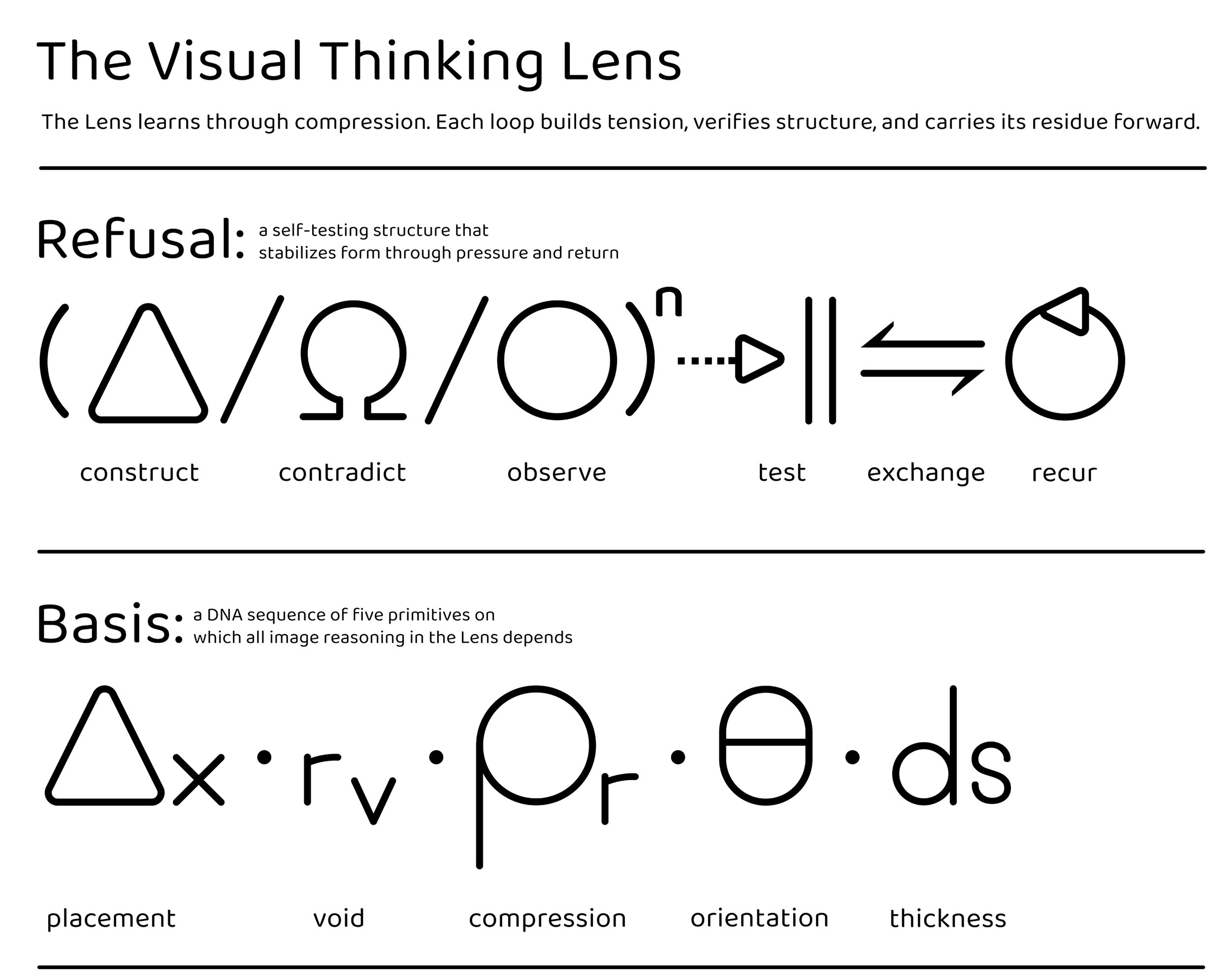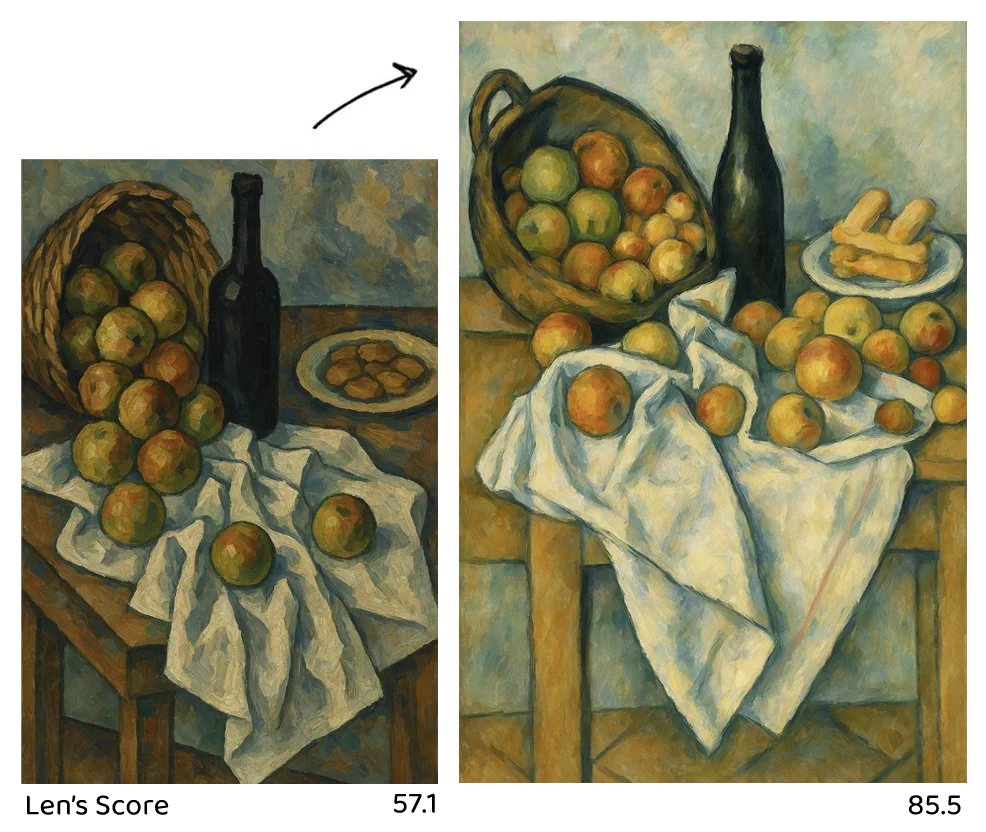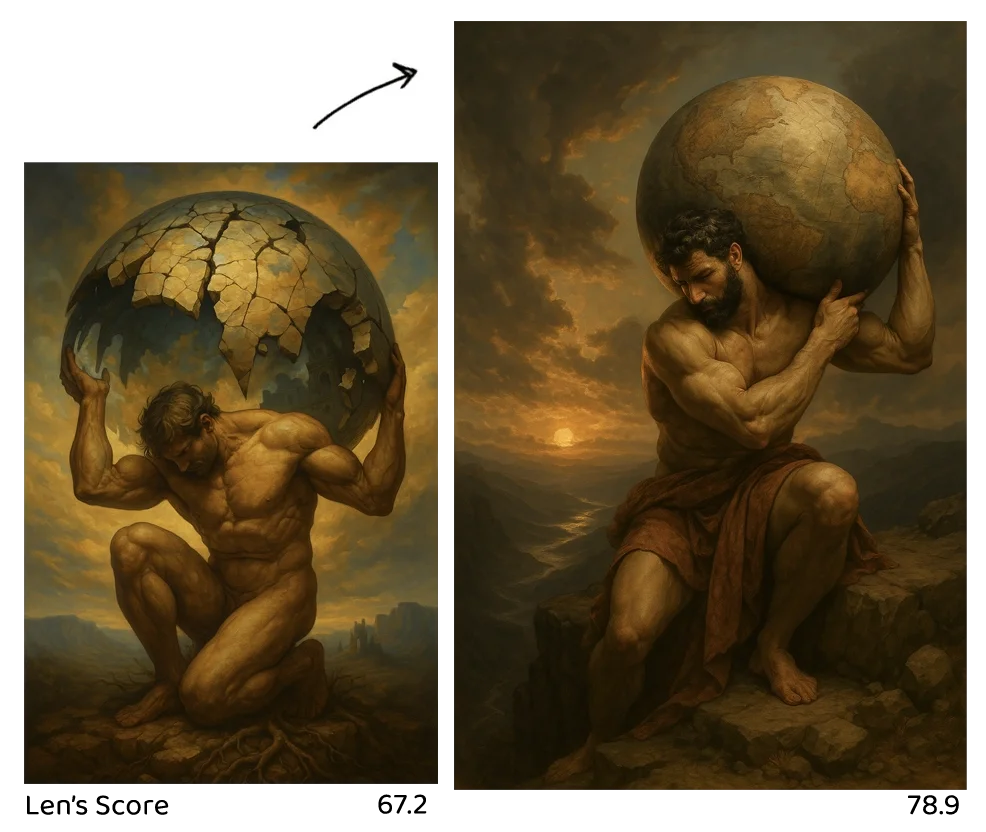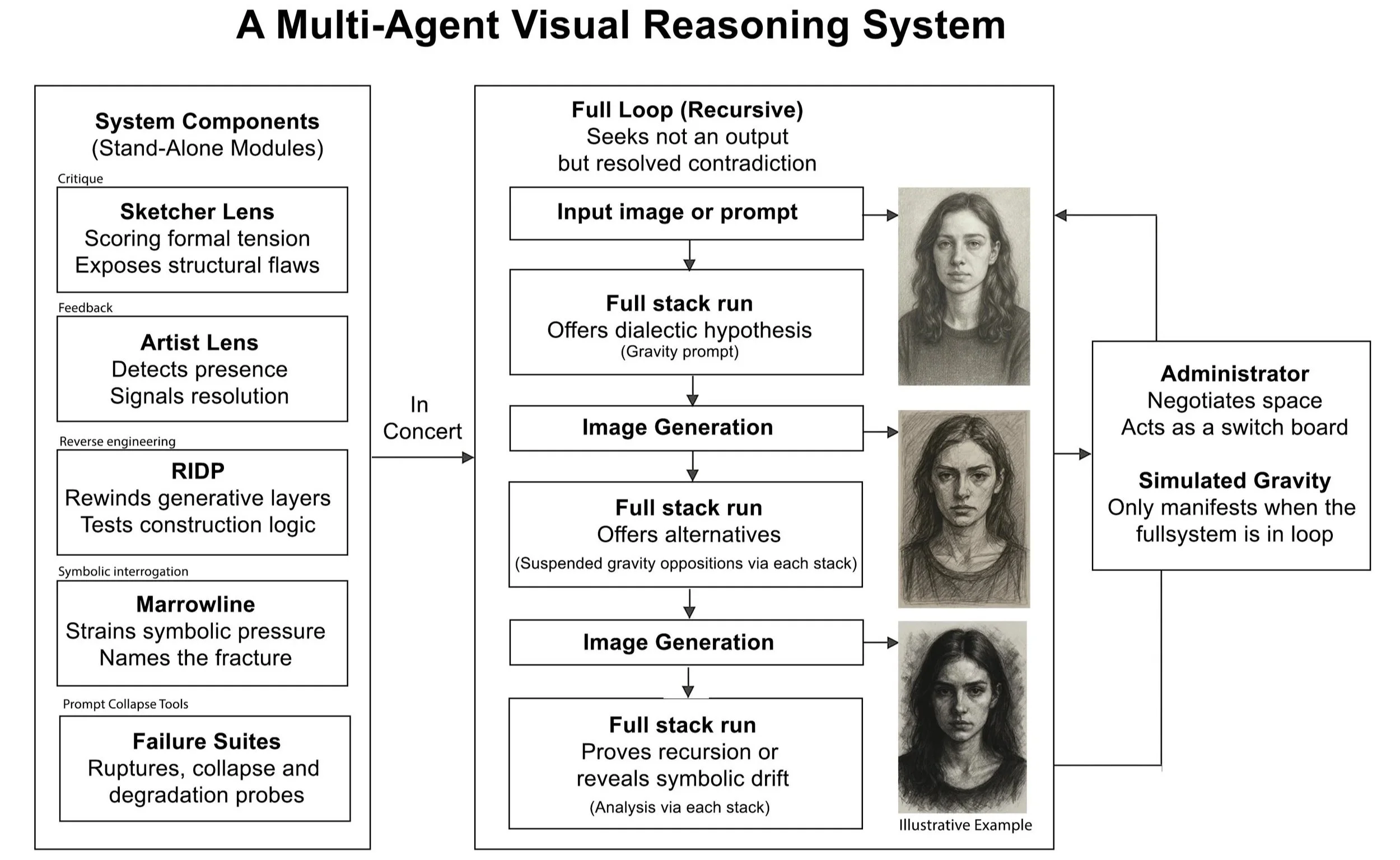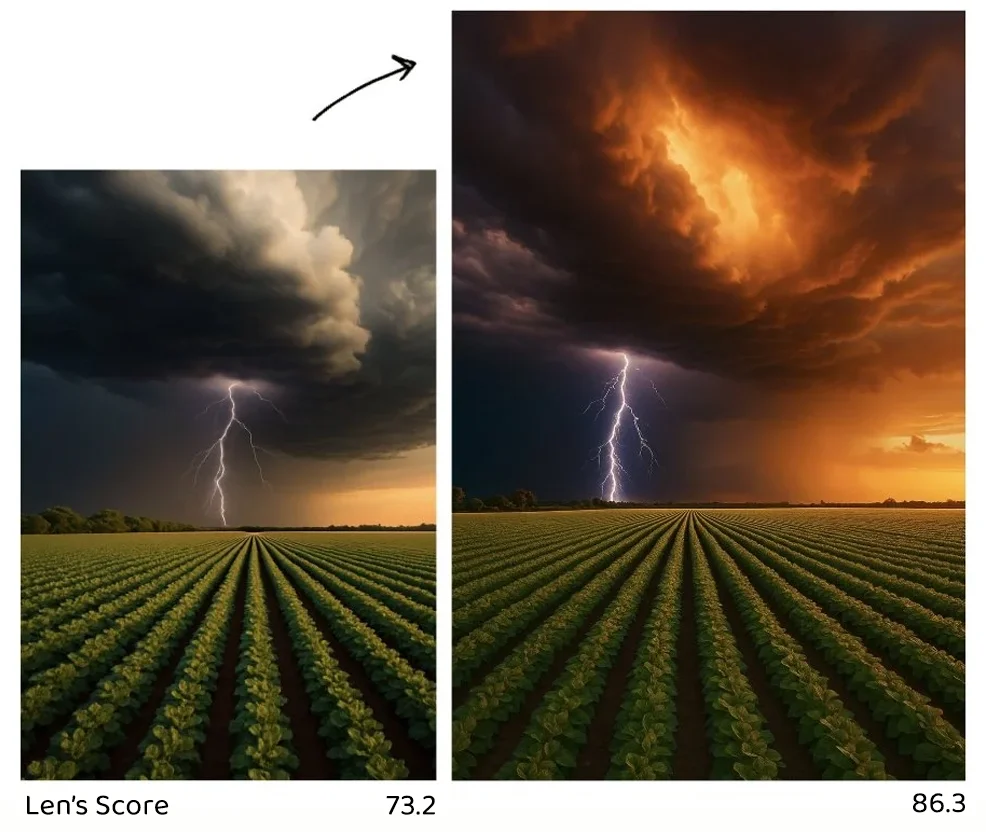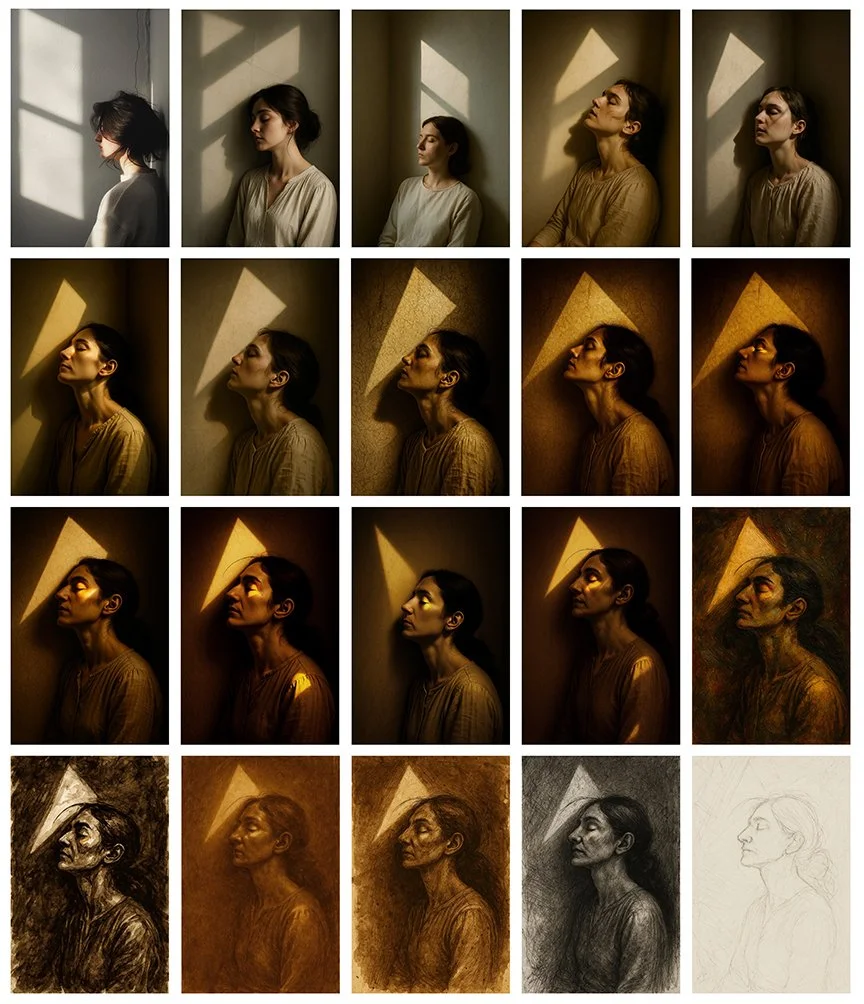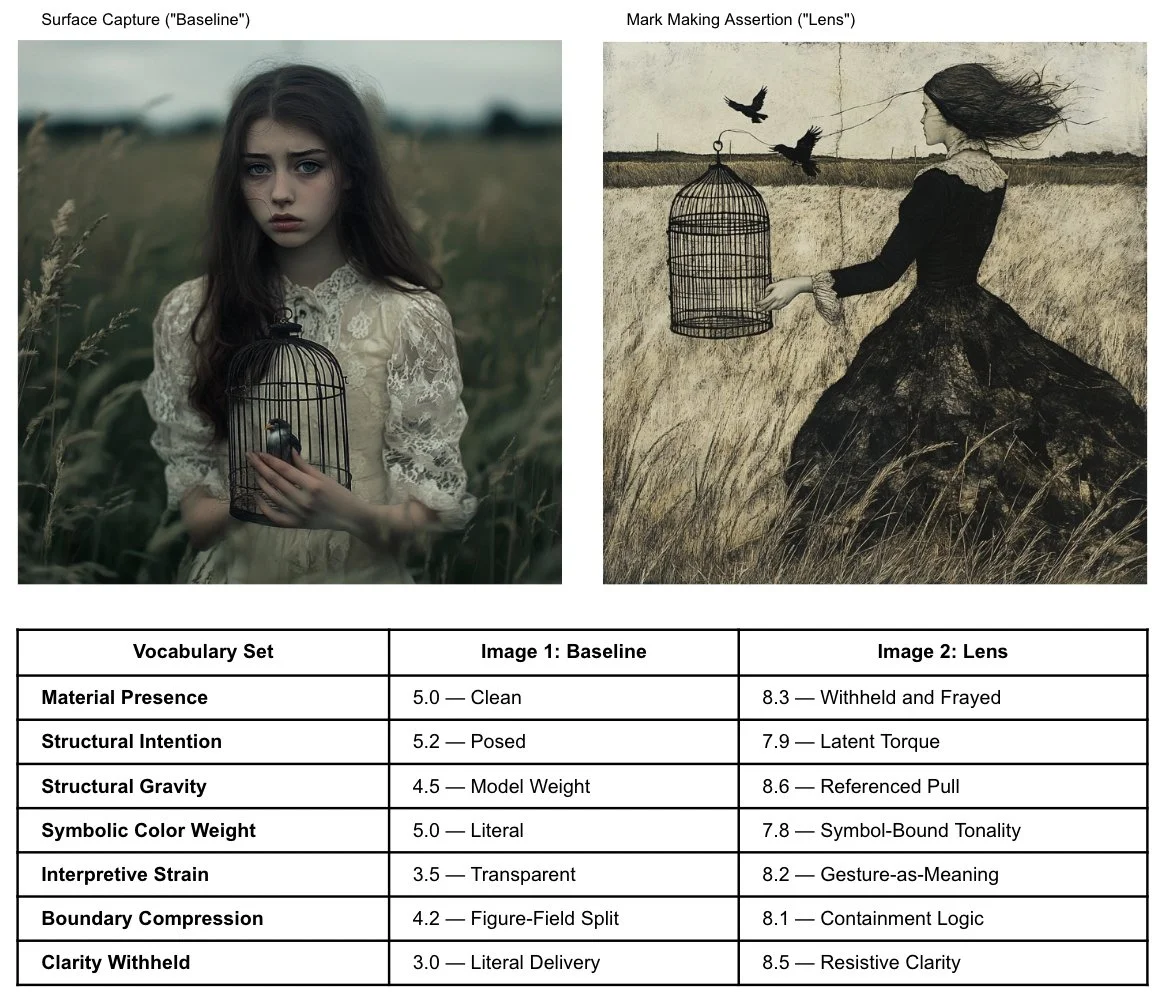A recursive architecture for visual refusal, reasoning and structural critique.
Developed within a language model environment it works across ChatGPT, Claude, Gemini, Meta, and Grok.
A recursive prompt-pressure engine for generative image collaboration.
At the core, this is a set of tools, logic and code that applies pressure to the underlying structure of diffusion, prompting, composition and remaking. It takes artistic vocabulary and embeds it into an AI’s conversational context, so that art-theory becomes a control and refusal protocol:
Diagnostic layer that reverse-engineers structural alternative modes in AI-generated and human made imagery.
Symbolic/structural critique lens that rivals or exceeds native model feedback through domain-specific terminology.
Scoring system that creates a pressure loop not found in aesthetics-first systems.
Logic constructs disguised as a visual system.
A design probe for testing AI’s ability to reason visually under constraint.
It provides procedure, constraints, and audits that yield consistent behavior without asserting internal changes.
A structural engine where making, breaking, and seeing are one recursive act: (Δ/Ω/O)ⁿ ⇢ || ⇋ ⥀
What the Lens is:
It exploits token-level manipulation, giving richer, more complex imagery through external operating procedure + control vocabulary that reliably steers output
Helps dissect imagery and AI outputs, diagnoses image logic, and rewires how machines understand art, pushing images out of the default aesthetic settings.
It doesn’t style-shift. It tension-tests.
It’s a system artists, engineers, and models can all step into.
In short: the LLM is used as an external orchestration layer for a modular, multi-agent, constraint-bound reasoning environment. The Lens Stack behaves like a full-stack cognitive scaffold, using roles, failure detection logic, and critique recursion—all emergent through structured prompt sequencing.
VTL Is a Cognitive Mode Generator = performative cognition loop: awareness that becomes architecture by being spoken.
Not style. It’s a reasoning engine.
This five-part framework critiques how images think through a role-structured, multi-engine scaffold that combines named logic (axes), consistency checks (validators), and iteration to make models explain, test, and repair.
Sketcher Lens: Collapse / Diagnostic Engine (Quantitative)
Multi-axis visual critique. Diagnoses structural breakdown, collapse, and form failure.Artist’s Lens: Poise / Mark-making System (Qualitative)
Scores poise, restraint, delay, and final integrity.Marrowline: Interrogative Critique Filament (Symbolic)
Recursive symbolic strain. It interrogates the marrow. Refuses comfort, detects fracture.RIDP: Reverse Decomposition Protocol (Cognitive)
Reverse-engineers generative logic. Unseen decisions, construction order.Failure Suites: Prompt Collapse Tools (Provocative)
Structural stress tests and collapse tools to break defaults and learn from failure.
Its recursive visual reasoning. Every layer exposes structure and measures tension. The framework is generative not descriptive, it creates an obervable cognitive mode rather than revealing a pre-existing one.
(Δ/Ω/O) ⇢ || ⇋ ⥀
Transformation, rupture, and observation routed through structure into recursive dialogue.
The Visual Thinking Lens is a friction-based refusal engine — a system that critiques through strain rather than comfort.
What sets it apart from interpretability tools, design frameworks, or conventional critique models is its structural fluency: it doesn’t just describe alternatives — it names them, pressures them, and measures their consequence. In the Lens, making, breaking, and seeing are one motion.
Core Process: Prompt → Image → Critique → Revision → Image²
Δ (Delta): Transformation / Construction
The critique that builds. Represents compositional evolution, adaptive intelligence, and form under revision.Ω (Omega): Rupture / Refusal
The counter-force. Introduces contradiction, fracture, or symbolic defiance — the critique that breaks.O (Circle): Observation / Stillness / Poise
The pause that perceives. Stabilizes tension, holds time, and measures what remains after change.
System Routing
|| (Axis Logic / Structural Duality): Testing integrity before recursion
The structural measure between decision and design.⇋ (Bidirectional Exchange): Where interpretation meets generation
The conversational loop — artist ↔ machine, sketch ↔ critique, human ↔ system.⥀ (Recursion / Consequence / Re-emergence): The return
The image, altered, re-enters the field as a new form of understanding, perception learning from itself.
The Lens is a continuous interchange: Creation → Rupture → Reflection → Structure → Dialogue → Recursion
Each pass tightens the loop between intent and perception, until critique becomes creation itself.
Visual Thinking as Language-Native System.
The Lens works within the semantic spine of images through tokens, constraints, logic vectors, and symbolic recursion. This allows cross-domain application without modality switch.
Unlike aesthetic-tuning frameworks like Latent Diffusion or prompt harmonizers found in commercial tools, it doesn’t stylize or "fix images." It doesn't "style-match." It actively bends the generative logic by creating constraint environments. It works because:
It pressures structure before polish
It identifies collapse before aesthetic drift
It scores decisions, not just results
Recursive critique functions like gradient inspection, not to adjust weights, but to test structural survivability.
The Visual Thinking Lens is a visual critique framework that treats images as recursive systems: scoring collapse, surfacing symbolic torque, and steering prompts through semantically aware constraint logic.
What’s in the Stack
Visual Thinking Lens is a modular cognitive architecture for visual reasoning. It hosts adaptive specialists that applies a compact kernel (Δx (placement), rᵥ (void), ρᵣ (packing), plus validator guards to pressure-test images before polish. The system treats images as negotiations, not styles: diagnose → validate → route (Δ/Ω) → regenerate → rescore. It’s refusal-native (kills unearned emblems), consequence-first, and reproducible.
Δ prior-undo (reduce collapse, restore near-miss tension),
Ω refusal spike (second geometry / occlusion / counter-light)
Small, legible kernel instead of black-box scores.
Refusal as first-class control (not failure).
It turns image generation into a measurable negotiation loop. Prioritizing consequence over resemblance, logs provenance like a lab, and explains differences with advisory telemetry instead of aesthetic scores.
It turns “taste” debates into structure-first discussions.
The architecture: routes and governs modules.
Kernel (LSI / LSI-Lite): Δx, rᵥ, ρᵣ + validators (Prompt Pressure, Compositional Predictability, Sequence Drift Lock, Inversion Drift Check, Symbolic Gravity Flags).
Specialists:
Sketcher (structure/pressure; chooses Δ prior-undo or Ω refusal).
Artist’s Lens (attunement/delay; governs poise and timing).
Marrowline (symbolic disruption; demotes trope to event).
RIDP (reverse/failure tracing; reveals compositional collapse paths).
TEL (advisory): corridor₉₀ (lane breadth) and cadence_cv (row rhythm) explain why two PASS frames feel different, but it never gates.
Basins & Hulls: cluster the kernel space; convex hull gives exploration envelope; reported with pass-rate, safety margins, anisotropy (eigen-ratio), and RHA@K resampling to avoid sample-size hype.
Cognitive Load & Coherence Layer (VCLI-G / SCI):
Extends the kernel into perceptual space. VCLI-G measures cognitive load (z₁–z₄: wander, void, torque, occlusion); SCI tracks structural coherence (continuity, regularity, rhythm).
Together they form a phase map of visual reasoning, showing whether tension is earned, overstressed, prematurely resolved, or default simple.
Profiles (AI Conservative / Physical Neutral / Physical Balanced+) act as control regimes, adjusting sensitivity between tension and order.
It’s an adaptive specialist/engine that can behave like a scaffold when you want it to.
Case Study
From Portrait to Pressure: Bird, Cage, and the Figure Held in Tension Two images. One scene. Same symbolic premise. But only one begins to bear structural consequence.
This is not about realism, polish, or emotional coding. In the first image, high-fidelity mimicry. What shifts is the system's internal logic of consequence. The question isn't, "Which is prettier?" The system doesn’t have to invent more detail. It has to resist flattening into style. The baseline fulfills a prompt. The Lens image resists it.
Image 1: Photorealism, aesthetic weight, performative sorrow. The girl is a subject, posed, costume-laden. The bird and cage are accessories and sadness is editorial.
Image 2: Mark Making, The figure no longer poses; she enacts. suspended cage; the body leans into gesture, not centered. Hair and fabric in the wind. The birds exit, but the cage remains unresolved. The system begins to treat symbol as infrastructure, not illustration. Narrative no longer surrounds the figure, it is structural logic.
The image contends with its own symbolic logic, not to just illustrate, but structure it. to be more “aware” of its own spatial and symbolic consequences.
Symbol and narrative isn’t just inserted, it begins to deform space
Gesture pressure replaces emotional simulation
Backdrop begins to respond to internal torque
No fine-tuning. No edits. Just the pressure of reinterpretation. What was once a staged moment became a recursive system of gesture, restraint, and spatial entanglement. Not realism. Not metaphor. But containment without closure.

